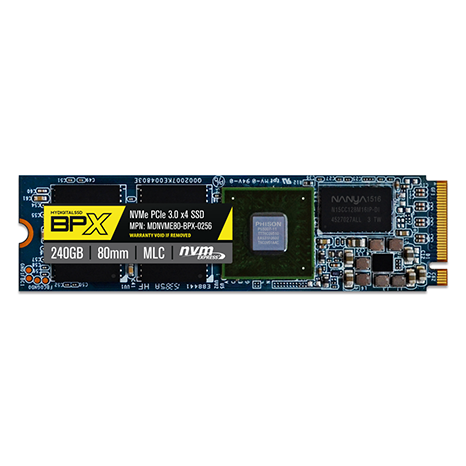The Ultimate Phison E7 Prototype NVMe SSDs
512GB Performance Results
Comparison Products
We don’t examine any new products in our article – it’s more to see what's cooking in Phison's test lab. The prototype designs we have for testing use older firmware. Some would argue that programming and firmware are just as important as the hardware design, and I’d agree with that statement. Over the years, we've seen how a simple firmware update can increase performance and deliver a better user experience. The latest mass-production firmware from Phison is a very good example. We tested the Patriot Hellfire M.2 with the initial release and new MP 2.1 firmware. The update increased performance and made the Hellfire M.2 more competitive against other modern NVMe products. You will be able to see this first-hand today. In some of the tests, both the Hellfire M.2 and BPX will outperform both of our prototype reference designs even though they have superior hardware.
We have a cast of leading 512GB-class NVMe SSDs in our test pool. We had to remove a couple of favorites because we have two drives under the microscope. We removed the entry-level Intel 600p 512GB and Samsung 960 EVO. Both drives utilize 3-bit per cell (TLC) NAND flash, leaving us with an all MLC lineup.
Sequential Read Performance
To read about our storage tests in-depth, please check out How We Test HDDs And SSDs. We cover four-corner testing on page six of our How We Test guide.


Reading sequential data back from the drives reveals that both of our reference designs are a little faster than the retail E7-powered BPX and Hellfire M.2 at high queue depths. The E7 SSDs are all very close under light loads between QD1 and QD4.
Sequential Write Performance
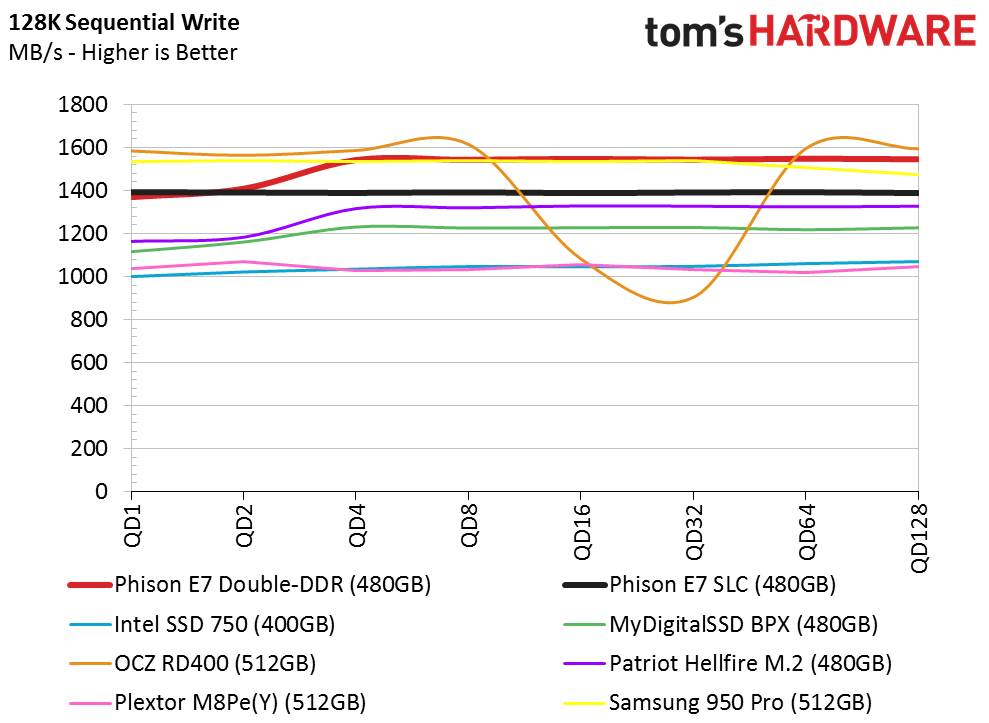
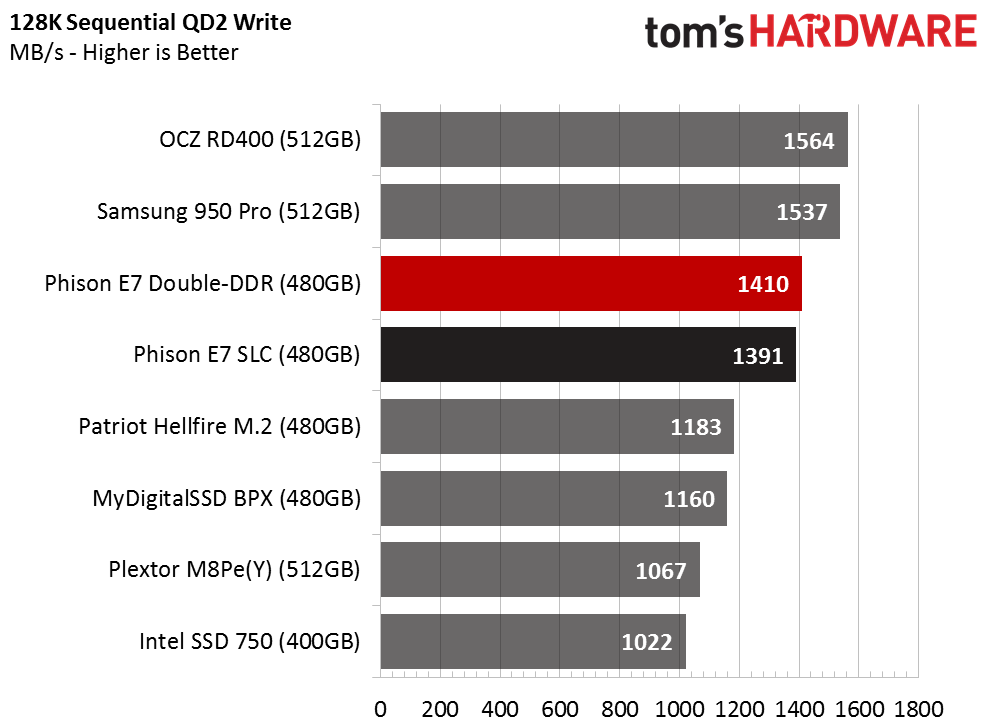
The two reference design cards boost the E7’s 128KB sequential write performance. We expected the SLC-enabled E7 to run away from the other E7 SSDs in this test, but instead, the double-DDR add-in card moved into the top performance tier with the OCZ RD400 and Samsung 950 Pro 512GB.
We still use a single worker, like the software you run on your PC, so our four-corner performance numbers do not represent the same inflated and unrealistic numbers that manufacturers show on NVMe SSD specification sheets.
Random Read Performance

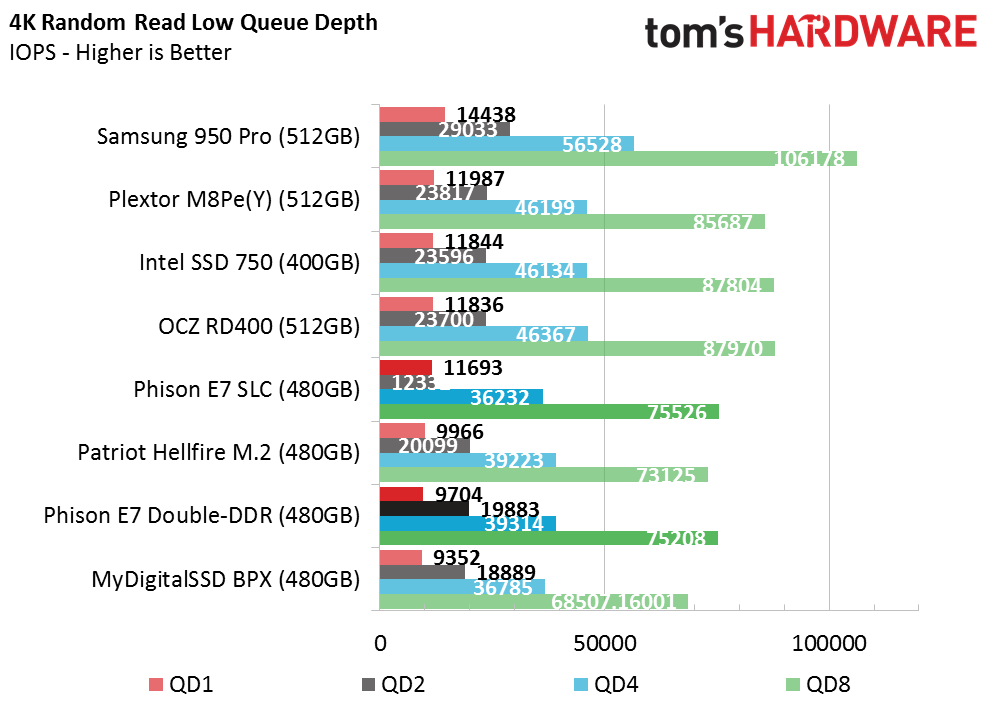

The random read test is like the sequential read test—we record nearly the same performance with all four of the E7-based drives. This is an area where the new firmware would have lifted the prototype reference cards. Phison didn’t optimize either card for its special abilities, but it would optimize the retail products if they come to market.
Get Tom's Hardware's best news and in-depth reviews, straight to your inbox.
Random Write Performance



We can say the same about the random write tests. Phison didn’t optimize the drives, so we're only looking at pre-production firmware.
80 Percent Sequential Mixed Workload
We describe our mixed workload testing in detail here and describe our steady state tests here.
That doesn't mean the drives can't stand above the crowd without optimizations. Take any 7'6" person, and they can dunk a basketball even if they've never played the game before. SLC, either in native form or as an emulated variant through a programming mode, will always be able to blast through a sequential mixed workload with ease. We would love to see the SLC prototype at retail, even if Phison only built and sold it as a special purpose SSD for multimedia professionals.
80 Percent Random Mixed Workload
The SLC-programmed E7 SSD requires a heavier load, and thus higher queue depths, to provide comparable mixed random performance to the other E7 drives. It still moves into a higher performance tier. The data center is another place where a product like this could be successful. It seems Phison isn't the only company looking to enhance flash by cutting the program density in the enterprise. Micron recently released the 5100 MAX with up to 70% overprovisioning. Given Samsung's large NAND performance lead, it may be the only way to build a competitive product with 3D NAND that, thus far, has proven to underwhelming.
Sequential Steady-State



The SLC model's mixed workload advantage carries over into steady-state conditions. The E7 with programmed SLC delivered one of the highest 80% mixed sequential results we've ever recorded in this test.
Random Steady-State


The prototype E7 SSDs with older firmware don't have the Phison firmware updates that increased performance consistency. The Patriot Hellfire M.2 with older firmware had a similar issue, but the MP 2.1 firmware tightened the results with genuine Toshiba 15nm MLC flash. We would love to see the performance of these prototypes with updated firmware, but we're not sure if it exists now. Hopefully, we see both make it to retail with mass production firmware.
PCMark 8 Real-World Software Performance
For details on our real-world software performance testing, please click here.

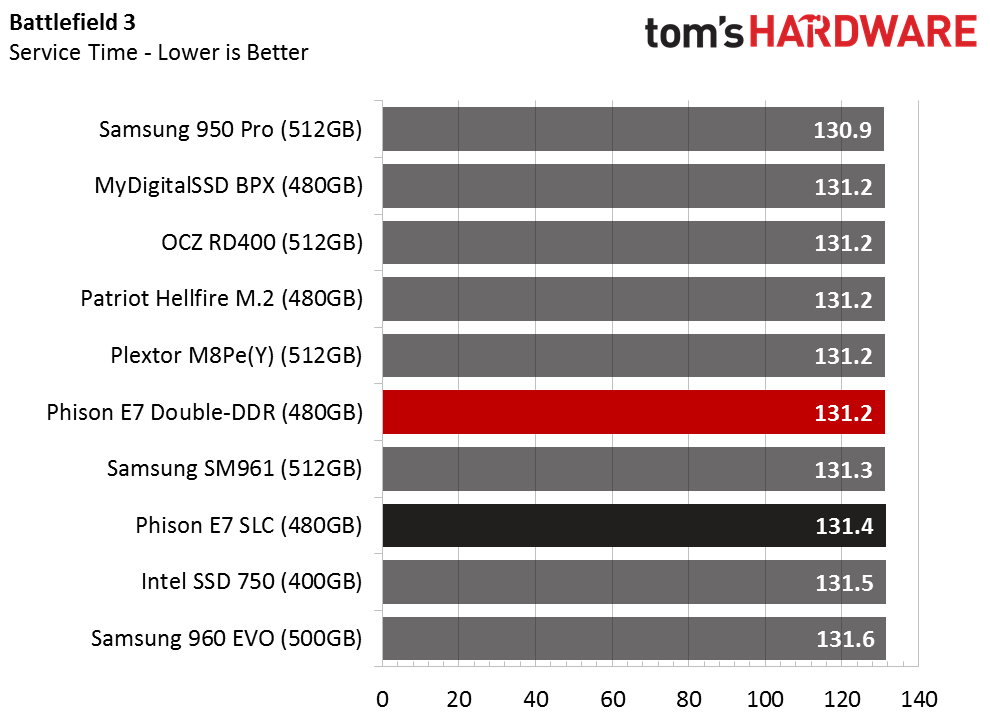


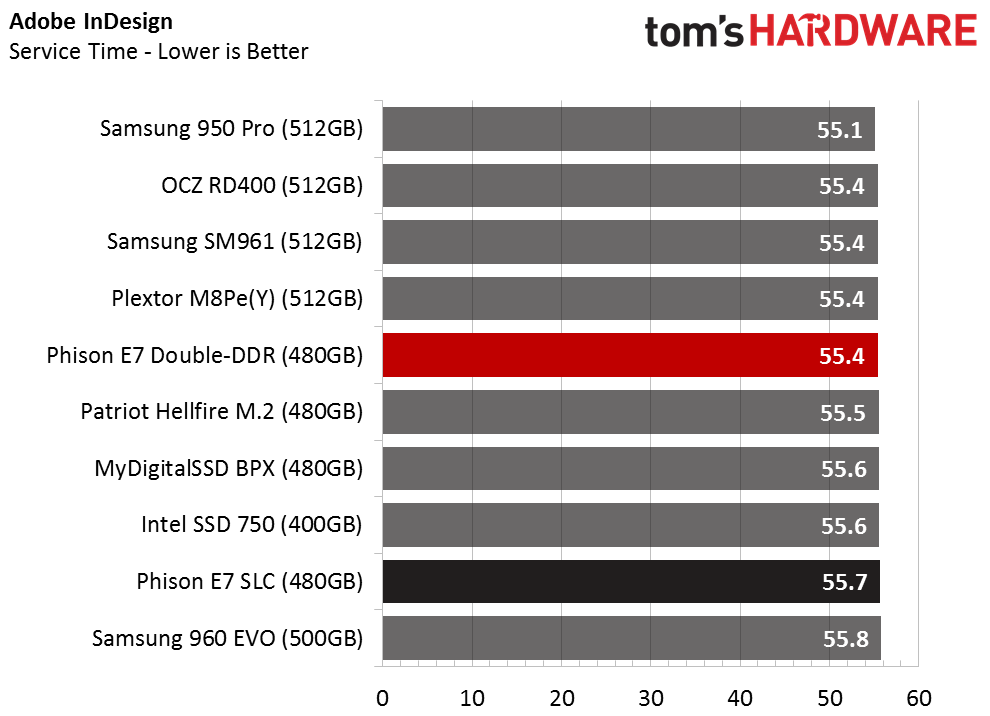





Firmware doesn't make for a very interesting topic because you can't see it. We can look at a controller, flash, and even DRAM, and understand which components are better than others. This set of tests shows us just how important the unseen can actually be. The MyDigitalSSD BPX is at or near the top of every test with lesser hardware. The BPX ships with the superior firmware and often outperforms the SLC drive.
Application Storage Bandwidth
Increasing the DRAM buffer capacity does increase real-world performance, as shown when we examine the averaged results. The Phison E7 double-DDR configuration will be a welcome addition to the consumer SSD market and a popular upgrade for users. The add-in card form factor isn't required for the E7 upgrade, either. The M.2 cards ship with a single DRAM package near the controller, but there is still an empty pad on the other side. Most E7 SSDs already ship in a double-sided configuration, so there are already components on both sides.
PCMark 8 Advanced Workload Performance
To learn how we test advanced workload performance, please click here.



The PCMark 8 Extended Storage Test shows that during heavy workload conditions both of our enhanced E7 SSDs deliver higher performance. The SLC model naturally performs better, but even the double-DDR model shrinks the gap between it and the Samsung 950 Pro.
Total Service Time

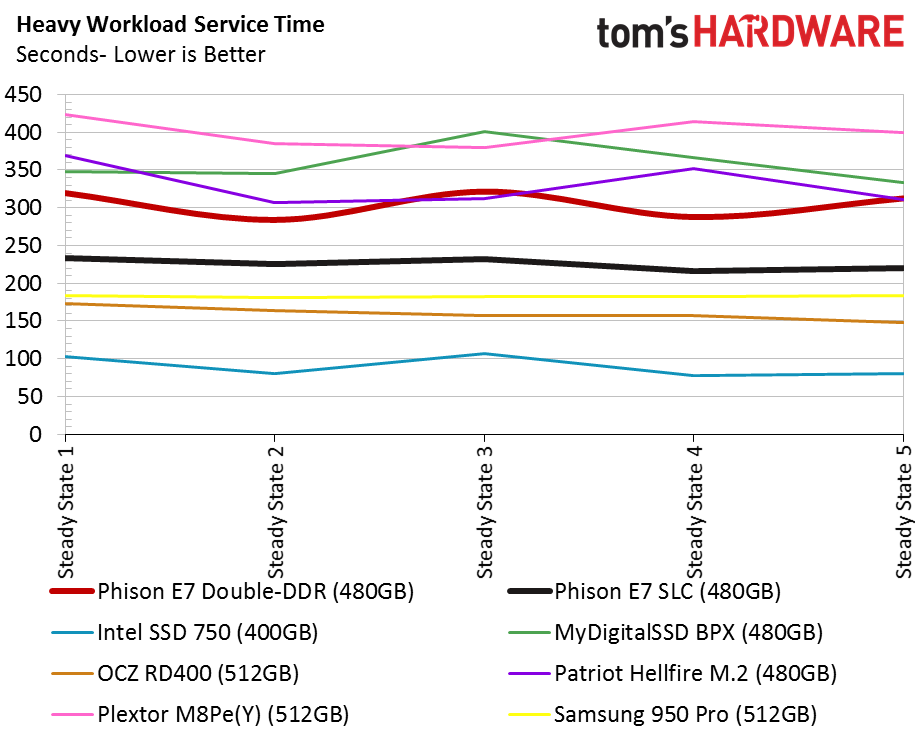

The recovery tests show that many of the NVMe SSDs perform about the same. NVMe has excellent light workload characteristics thanks to the low interface and protocol latency. The Phison PS5007-E7 has proven itself as one of the better controllers for real-world workloads with software we all use every day. Performance won't increase much for daily-use software if either of these designs make it to market, but professional software with a higher write mix would see a sizable performance increase.
MORE: Best SSDs
MORE: How We Test HDDs And SSDs
MORE: All SSD Content

Chris Ramseyer was a senior contributing editor for Tom's Hardware. He tested and reviewed consumer storage.
-
kalmquist If it were purely a matter of cost of materials, one might expect a 240 GB SLC drive to cost the same as a 480 GB MLC drive. That would probably get some customers looking to combine a fast boot drive with a slower drive for mass storage, but not necessarily enough to cover the engineering and validation costs.Reply -
jchang6 An SLC device priced the same as 2X capacity MLC would definitely be interesting, more so if it could be programmed by the userReply -
drajitsh It is speculated that Samsung Z-nand could be 3d-SLC. With a large memory buffer (with power loss caps, of course), a specially made for SLC controller, and a SLC specific firmware it could challenge intel x point.Reply -
lsorense Using the flash in pseudo SLC mode does not mean ignoring half the flash. It also does not mean using twice as many cells to store things. What it does mean is that instead of storing 2 bits per cell as MLC does, you store 1 bit instead, by not using the two middle voltage levels. So if MLC mode stored 00, 01, 10, and 11 using the voltages 0, 0.5, 1.0 and 1.5 (I am sure these are not the right ones, but it's the idea), pseudo SLC mode would just store 0 and 1 using 0 and 1.5 volt. This has the advantage for reliability that you can treat any cell with a value of between 0 and 0.6 as a 0 and any value between 0.9 and 1.5V as a 1, which is much more tolerant of cell wear than MLC mode where you have to be more in the range of 0 to 0.2V, 0.4 to 0.7V, etc. Since it has much more tolerance, it can stay working much longer than in MLC mode. Whether using it in pseudo SLC mode makes it any faster than MLC I don't know. I don't actually see why it should, but perhaps reading and writing the middle voltage levels is slower than just the top and bottom.Reply

